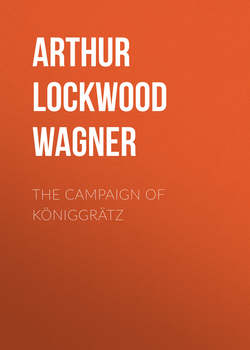Читать книгу The Campaign of Königgrätz - Arthur Lockwood Wagner - Страница 9
THE CAMPAIGN OF KÖNIGGRÄTZ
JUNE 26TH
ОглавлениеOn the 26th of June the Army of the Elbe marched upon Niemes and Oschitz. The advanced-guard encountered an Austrian outpost near Hühnerwasser, and drove it back after a sharp skirmish. The main body of the Army of the Elbe bivouacked at Hühnerwasser, with outposts towards Weisswasser, Münchengrätz and Gablonz. In the evening there was another brisk outpost fight in the direction of Münchengrätz, in which the Austrians were again worsted.
In the First Army the advance on this day was begun by General Von Horn, whose division had held the outposts the night before. At Liebenau Von Horn struck the Austrians, whose force consisted of a small body of infantry, four regiments of cavalry and two batteries of horse artillery. Driven out of the village, and from the field where they next made a stand, the Austrians retreated across the Iser, via Turnau, to Podol. The First Army now occupied a position extending through Reichenberg, Gablonz, Liebenau and Turnau; Von Horn’s division extending down the Iser from Turnau, with outposts near Podol. Free communication—in fact a junction—was now established with the Army of the Elbe, one division of which occupied Bömisch Aicha.
An attempt made by a company of Prussian riflemen to seize the bridges at Podol, about dusk in the evening, brought on a sharp fight. The forces on each side were reinforced until parts of two Prussian and two Austrian brigades were engaged. A stubborn infantry battle was carried on by moonlight until 1 o’clock in the morning, when the Austrians retreated towards Münchengrätz. By this victory the Prussians secured the passage of the Iser at Podol; the shortest line to Gitschin was opened to them; the communications of Count Clam-Gallas with the main army were threatened; and a plan which he had formed to riposte upon the Prussians at Turnau was thwarted.
We will now turn to the Second Army. On this day the Ist Corps concentrated at Liebau and Schomberg, ready to cross the frontier. The Vth Corps was at Reinerz, about twenty miles from the Ist. The Guard Corps, which had just crossed the frontier, in front of Neurode, midway between the two corps, was in a position to support either. The VIth Corps was at Landeck and Glatz, part of its cavalry being sent forward to cover the left of the Vth Corps and maintain communication between the two. After passing the mountains, the entire army, pivoted on Nachod and Skalitz, was to wheel to the left, seize the Josephstadt-Turnau railway, and form a junction along that line with the armies of Frederick Charles. On the evening of the 26th, the advanced-guard of the Vth Corps occupied Nachod. The distance between the Crown Prince and Frederick Charles had now been reduced to about fifty miles, while the distance between the extreme corps of the Austrian army was about the same. Von Benedek’s strategical advantages were already beginning to disappear. The Prussian demonstrations towards Olmütz had caused the Austrian IId Corps to be retained dangerously far to the right; Count Clam-Gallas was struggling against superior numbers on the Iser, and Von Benedek had only four corps with which he could immediately oppose the four corps of the Crown Prince.
No. 4.
POSITION OF BOTH ARMIES ON THE EVENING OF THE 26TH. JUNE.
The Austrian commander ordered the following movements for the next day:
The Xth Corps, from Josephstadt and Schurz, upon Trautenau;
The VIth Corps, from Opocno to Skalitz;
The IVth Corps, from Lanzow to Jaromir;
The VIIIth Corps, from Tynist to beyond Jaromir, to support the VIth;
The IIId Corps, from Königgrätz to Miletin;
The IId Corps, from Senftenberg to Solnitz;
The Reserve Cavalry, from Hohenmauth and Wildenschwerdt to Hohenbrück;
The Light Cavalry to accompany the IId Corps.
